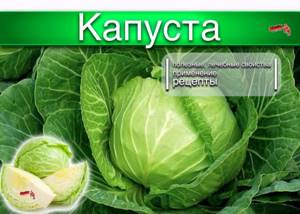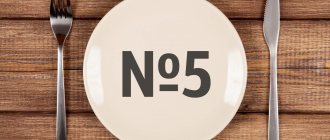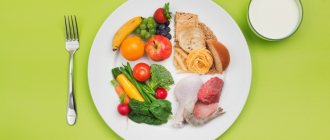What is worth knowing about bread units and what is the advantage of this system. The most popular products per 1 XE.
For diabetic patients, the main task is to normalize the diet and control the carbohydrates entering the body. The main thing is to follow a number of rules, because each product differs in three parameters:
- caloric content;
- properties;
- composition.
To simplify the process of organizing proper nutrition, a special term has been developed - “bread unit”, and also a table of bread units in products, abbreviated as XE, has been drawn up.
Generally speaking, XE is a conventional unit used by nutritionists to calculate the carbohydrate content of various foods. The concept was developed for diabetics on insulin, who have to calculate the dose of the latter taking into account the carbohydrates consumed. Knowing the volume of XE in each specific product allows you to accurately create a diet and eliminate the risks associated with a jump in glucose.
Bread diet for weight loss according to Israeli and German methods: their features and menu for the week
Almost any diet involves limiting carbohydrates. Weight is lost by reducing energy consumption.
On the other hand, this is precisely what entails decreased performance, lethargy and a constant feeling of hunger. However, a new nutrition system has emerged that goes against the usual postulates.
This is the bread diet, which Olga Raz-Kestner, an Israeli nutritionist, first told the world about.
Effect on the body
It is well known that the main enemy of a beautiful figure is carbohydrates. It is on this statement that most nutritional systems that promote weight loss are based: they advocate either complete or partial rejection of high-calorie foods.
Olga Raz was able to experimentally prove the opposite. Her main discovery was the fact that low-carb diets reduce serotonin levels in the body. This is the same hormone of happiness.
It is not difficult to guess what happens to a person when he loses this little wizard.
The mood deteriorates sharply, the appetite grows, and the feeling of hunger eventually becomes almost uncontrollable.
The bread diet avoids these side effects. It provides the body with the necessary amount of carbohydrates, and meanwhile, weight loss will occur by limiting other foods and portion sizes.
The basis is low-calorie bread, which is made from whole flour (bran, rye) or bread. It contains a lot of vitamins (E, B1, B2), minerals (magnesium, phosphorus, calcium, potassium, etc.). The maximum number of calories consumed is limited to 35-45.
The actual mechanism for losing weight is extremely simple: bread rich in coarse fibers does not provoke a sharp release of glucose and insulin. Energy is produced by the body more slowly and is consumed gradually. As a result, no fat deposits are formed in problem areas.
A bread fast can last quite a long time, as it does not limit physical activity and does not reduce performance. But usually it lasts for a week. And don’t expect stunning results: they will be minimal (4 kg), but lasting.
Recommendations
To lose weight on bread without harm to your health, you need to follow certain rules. It’s worth mentioning right away that the nutrition system from Olga Raz formed the basis for many other methods for combating excess weight. Each of them has its own nuances, but we will prescribe postulates common to all, since the main product is one - bread.
- Eat small and often meals (at least 5 times a day).
- Meals should be at the same time.
- The interval between them should not exceed 4 hours.
- It is strictly forbidden to skip them, even if there is no feeling of hunger.
- The drinking regime involves drinking 2 liters of water.
- The main product is dietary bread. In extreme cases, it can be replaced with rye, but in this case the portion is reduced by 2 times.
- Since the diet is not varied, it is advisable to take multivitamins.
- Exercising will speed up the burning of fat deposits. If you feel weak and unwell, provide at least light physical activity. This could be walking, skipping rope, yoga or dancing.
- To prevent lost kilograms from returning, exiting the diet should be gradual: follow a diet, drink plenty of fluids, do not eat white bread, replace sugar with honey or stevia.
The stricter the diet, the more accurately you adhere to its rules, the more beneficial it will be for your health and the better the results will be.
Contraindications
You should not use bread for weight loss if you have the following contraindications:
- pregnancy;
- lactation;
- children's and elderly age;
- any problems with the gastrointestinal tract;
- inflammatory processes in the liver and gall bladder.
Do not forget that bread is a high-calorie product that cannot be eaten in large quantities if you have certain diseases.
Advantages and disadvantages
In order for a diet to help achieve the desired results without harm to health, it is worth assessing its positive and negative aspects in advance.
Advantages:
- promotes weight loss even if you are obese;
- allowed for atherosclerosis, diabetes;
- removes free radicals, toxins, heavy metal salts, waste, excess liquid;
- hunger is not felt at all;
- compatibility with physical activity;
- budget;
- unlimited terms;
- weight does not return (with proper exit);
- slight and gradual weight loss leads to the absence of sagging skin, stretch marks, and depletion of muscle mass;
- the craving for sweets is dulled.
Flaws:
- the lack of proteins can still negatively affect muscle mass;
- lack of fat can worsen metabolism;
- deficiency of calcium and vitamins.
To ensure that the results do not disappoint you, take into account all the disadvantages and try to somehow eliminate them, following the recommendations of experts.
Israeli bread diet
After the unique discovery of Olga Raz, other nutritional systems based on losing weight with bread were created. Therefore, you have a choice which of the modern methods suits you best than others. But the most popular is still the Israeli bread diet from a professional in his field. It involves 2 stages.
Stage I
At this stage, active weight loss occurs. It is allowed to eat low-calorie bread with a thin layer of “spread” with a minimum amount of fat. On the day it is recommended to eat:
- women - up to 12 pieces;
- for men - up to 16.
The diet is supplemented with protein foods and vegetables. The duration of the stage is 2 weeks.
Authorized products:
- sandwiches with cottage cheese (up to 5% fat), fish (even salted), lean meat (chicken, turkey, quail, beef, veal);
- ham;
- vegetables without starch: cabbage, zucchini, bell peppers, tomatoes, broccoli, asparagus, green peas, lettuce;
- eggs (three times a week);
- fermented milk drinks (yogurt, fermented baked milk and kefir) - a glass a day;
- three times a week you need to eat meat or fish with vegetables, but on such days the serving size of bread is reduced by a third;
- fruits: plums, avocados, apples, pears (1 piece per day);
- vegetable oil in small quantities for salad dressing;
- coffee (occasionally), green tea, vegetable juices (celery, tomato, carrot).
Stage II
This stage represents consolidation of the achieved results. The goal is not to regain lost weight. The diet is gradually expanded with other products. The duration of the stage depends on individual indicators. On average - 2-3 weeks.
Authorized products:
- porridge;
- pasta;
- potatoes (1 piece per day);
- legumes: beans, lentils;
- the portion of fruit increases (3 pieces per day).
For both stages there is a list of prohibited products:
- sweets: honey, sugar, sweets, confectionery, chocolate, marmalade;
- smoked foods, pickles, sauces, marinades;
- alcohol;
- ketchup, mayonnaise;
- carbonated drinks;
- bakery;
- preserves and jams;
- food with animal fats;
- fat meat;
- some dairy products: milk, homemade cottage cheese, sour cream.
With such a diet, fats practically do not enter the body, which means that it will not have the opportunity to store them in reserve.
Diet based on bread units
The German diet based on bread units is structured differently - a low-carbohydrate nutrition program recommended for patients with diabetes. Similarities with Olga Raz’s system are in a balanced and varied diet and duration. The basis is the calculation of the daily carbohydrate intake.
All products are measured in bread units (XU) to provide an approximate estimate of their carbohydrate content:
- 1 XE = 10 grams of carbohydrates (without dietary fiber);
- 1 XE = 13 grams of carbohydrates (with ballast substances);
- 1 XE = 20 grams of bread.
It is usually recommended to consume no more than 30 XE per day. The daily norm can be distributed as follows:
- 4 XE - in main meals;
- 2 XE - for an afternoon snack;
- You cannot consume more than 7 XE at a time.
However, a diet based on bread units reduces their daily amount to 10. For calculation, German nutritionists have developed a special table. If it does not contain a certain product, its use as part of weight loss is not limited.
Sample menu
The bread diet is difficult, first of all, in creating a menu. To make this task easier, we offer you an approximate option for 7 days using the system from Olga Raz:
Menu for the week based on bread units
If you can’t go on a diet because you feel hungry, it makes sense to turn to this weight loss method. Bread, despite all its caloric content, will allow you to put your diet in order, improve your well-being, and most importantly, it will not allow you to suffer due to lack of energy. With this product, it is much easier to fight excess weight than with any other mono-diet - you can see this for yourself.
Source: https://hudeyko.ru/hlebnaya-dieta-dlya-pohudeniya.html
Sample menu
The bread diet is difficult, first of all, in creating a menu. To make this task easier, we offer you an approximate option for 7 days using the system from Olga Raz:
Menu for the week based on bread units

If you can’t go on a diet because you feel hungry, it makes sense to turn to this weight loss method. Bread, despite all its caloric content, will allow you to put your diet in order, improve your well-being, and most importantly, it will not allow you to suffer due to lack of energy. With this product, it is much easier to fight excess weight than with any other mono-diet - you can see this for yourself.
According to modern statistics, more than three million people in the Russian Federation suffer from diabetes at various stages. For such people, in addition to taking the necessary medications, it is very important to plan their diet.
Typically, this is not the easiest process and involves a lot of calculations. Therefore, here we present how many units of bread to consume per day for type 2 and type 1 diabetes. Will be compiled.

To begin with, “bread units” (sometimes abbreviated to “XE”) are conventional carbohydrate units that were developed by nutritionists from Germany. Bread units are used to estimate approximate content.
For example, one bread unit is equal to ten (only when dietary fiber is not taken into account) and thirteen (when all ballast substances are taken into account) grams of carbohydrate, and this is equal to 20-25 grams of ordinary bread.
Why do you need to know how many carbohydrates you can eat per day if you have diabetes? The main task of bread units is to provide glycemic control in diabetes. The thing is that a correctly calculated number of bread units in a diabetic’s diet improves carbohydrate metabolism in the body.
Heh - this is not for you hehe
11:31, July 28, 2017
Bread unit helps diabetics live and keep sugar in check.
It is abbreviated as XE - this is a measure of carbohydrates in foods. One bread unit is equal to twelve grams of sugar or twenty-five grams of black bread. A certain amount of insulin is spent on the breakdown of one unit of bread, on average equal to two action units in the morning, one and a half units in the afternoon and one action unit in the evening.
Information about how many bread units are contained in a specific amount of product greatly simplifies the life of a patient with diabetes, as it helps determine the required dose of insulin for each injection.
The numbers may vary depending on the individual characteristics of the human body, so all patients are recommended to initially keep a food diary in which they note the fasting glucose level, the dose of insulin administered, the foods taken, their quantity and the glucose level after meals. Based on these data, monitored for two to four weeks, it is possible to draw a conclusion about the amount of an individual dose of insulin required to break down one unit of bread.
Why do they need to be counted?
Many people know that in diabetes mellitus the patient’s nutrition plays a decisive role.
Indeed, regulating the intake of carbohydrates from food greatly facilitates the selection of the correct dose of insulin, but it is very difficult to calculate the required amount of certain foods daily, for many years, and everything that is difficult is usually ignored by people. That is why the concept of “bread unit” was introduced, which made it easier to calculate nutrition for millions of people suffering from one form or another of diabetes.
How to calculate?
A diabetic should always have a table of bread units on hand, which indicates how much carbohydrate is in a particular product, equivalent to 1 XE (12 g of carbohydrates).
Such tables have long been developed and are the basis for creating a menu for the day.
In the event that this table is not at hand, and you are standing in a store and don’t know what is best to choose, then you can easily calculate how much XE is in the product.
You look at the label, which indicates the amount of carbohydrates per 100 grams of product. After this, you need to divide this value by 12 (1 XE = 12 grams of carbohydrate, as you remember). The resulting figure is the number of bread units per 100 grams of product. Now all that remains is to simply weigh the product that you will consume and count the XE in this amount.
You need to calculate it like this: for example, 100 grams of cookies contain 50 grams of carbohydrates. 50 must be divided by 12 to determine XE, the result is 4. If you are going to eat 150 grams of this cookie, then in total you will consume 6 XE. It is for this amount that you need to calculate how much insulin you will need.
How much can you eat?
Traditionally, there are three main meals - breakfast, lunch and dinner, so they account for the largest amount of carbohydrates.
You can eat no more than seven bread units at the same time, since you cannot simultaneously administer more than 14 units of short-acting insulin (2 units of insulin are administered per 1 XE).
An approximate distribution of bread units during the day may look like this: breakfast and lunch - six XE each, for dinner - five XE and three XE are distributed throughout the day for so-called snacks - second breakfast, afternoon snack and second dinner.
Knowing how many units of bread can be eaten, the patient looks at special tables and selects those foods that cause appetite, meeting the selection criteria. Thus, the patient’s nutrition will be varied and complete.
Important Rules
XE tables
There are detailed tables that indicate the name of the product, its quantity in grams, kilocalories and bread units. They can be found in clinics with endocrinologists, in special books and on the Internet.
One bread unit contains:
- one glass of milk, curdled milk or yogurt;
- one regular piece of black bread and a slightly smaller piece of white bread, two crackers, five crackers;
- two heaping tablespoons of any boiled cereal, three tablespoons of boiled pasta, ten tablespoons of popcorn without sugar, one pancake, two dumplings, four dumplings, half a meat pie, one cutlet;
- two level teaspoons of sugar or honey, one medium boiled potato, two apricots, one large quince, one orange, one eighth of a watermelon, half a banana, twelve cherries, ten grapes, one small pear, one large pomegranate, half a grapefruit.
Bread units are, of course, a very important concept for a patient suffering from diabetes, so you must definitely use them and lead a healthy lifestyle, eating healthy and varied.
Prepared by Tatiana PETROVA.
Source: https://www.vest-news.ru/article/100013
Bakery products
| Product | 1 XE in grams of product |
| Vanilla bagels | 17 |
| Mustard bagels | 17 |
| Poppy bagels | 18 |
| Butter bagels | 20 |
| Puff bun | 20 |
| Medium loaf | 24 |
| Loaf with raisins | 23 |
| Bran loaf | 23 |
| Biscuit with strawberries and cream | 60 |
| City bun | 23 |
| Poppy bun | 23 |
| Bun with jam | 22 |
| Butter bun | 21 |
| Bun with cheese | 35 |
| French bun | 24 |
| Potato cheesecake | 43 |
| Cheesecake with jam | 27 |
| Cheese cheesecake | 22 |
| Cheesecake cheesecake | 30 |
| Cheesecake with raisins | 28 |
| Cake | 28 |
| French croissant | 28 |
| Croissant with jam | 23 |
| Walnut croissant | 23 |
| Cheese croissant | 34 |
| Chocolate croissant | 25 |
| Croissant with butter cream | 26 |
| Armenian lavash | 20 |
| Uzbek lavash | 20 |
| Georgian lavash | 21 |
| Pea flour | 24 |
| Buckwheat flour | 21 |
| Corn flour | 16 |
| Flaxseed flour | 100 |
| Oat flour | 18 |
| Wheat flour | 17 |
| Rye flour | 22 |
| Rice flour | 15 |
| Low-fat soy flour | 43 |
| Curd cookies | 35 |
| Cherry pie | 26 |
| Cabbage pie with meat | 38 |
| Cabbage pie with egg | 34 |
| Potato pie | 40 |
| Potato pie with meat | 34 |
| Meat pie | 30 |
| Pie with jam 21 | 21 |
| Fish pie | 46 |
| Cottage cheese pie | 34 |
| Apple pie | 32 |
| Pizza with tomatoes, cheese and salami | 45 |
| Rye donut | 32 |
| Puff pastry without filling | 23 |
| Puff pastry with boiled condensed milk | 22 |
| Puff pastry with raisins | 20 |
| Poppy puff pastry | 23 |
| Curd puff | 21 |
| Vanilla crackers | 18 |
| Milk crackers | 18 |
| Breadcrumbs | 18 |
| Wheat crackers | 16 |
| Rye crackers | 17 |
| Rusks with raisins | 18 |
| Poppy crackers | 19 |
| Nut crackers | 20 |
| Cream crackers | 16 |
| Vanilla crackers | 17 |
| Crackers with glaze | 18 |
| Drying poppy seeds | 18 |
| Salted dryers | 20 |
| Curd cake with cream | 38 |
| Borodino rye bread | 29 |
| Wheat bread | 24 |
| Wheat bran bread | 27 |
| Rye-wheat bread | 26 |
| Yeast-free rye bread | 29 |
| Rye custard bread | 26 |
| Rye bran bread | 26 |
| Borodino bread | 23 |
| Buckwheat bread | 23 |
| Rye bread | 22 |
| Rice cakes | 17 |
| Bran bread | 17 |
What is XE and a table of bread units of various food products
Bread units, the table of which is presented below, help to count the intake of sugars.
It is necessary to take into account bread units when compiling a dietary diet along with such an indicator as the glycemic index.
The only caveat is that you need to count them correctly, because all types of food differ in their properties and composition. First of all, you need to understand what this indicator means.
Concept of grain units
Bread units are an indicator that allows optimizing compensation for disturbances in carbohydrate metabolism processes. This indicator may vary slightly depending on the type of carbohydrates contained in food products: they can be digestible or not digestible, they can be soluble or insoluble, digestible quickly or slowly.
So, cabbage is a soluble, non-digestible carbohydrate. It swells in the stomach, gives a feeling of fullness, at the same time absorbs sugar and makes it easier to eliminate.
Once a patient is diagnosed with diabetes, especially type 1 diabetes, people have to make major changes to their daily diet. First of all, it is necessary to limit the intake of various sugars into the body, since they are the ones that increase blood glucose levels. But this does not mean that they will have to be completely excluded from the diet.
XE can be a kind of “measuring spoon” that allows you to prevent hypo- or hyperglycemia in diabetic patients and calculate the amount of food required per day. The diet should be changed for people who suffer from both type 1 and type 2 diabetes.
[]sjsk-d-KU[/]
It is extremely important to be able to select a diet taking into account the amount of XE, because this will help simplify food intake. Apart from bread units, the variety of the daily menu can suffer greatly, since with any change in the diet, glycemia will also change, which is already impaired when type 1 diabetes occurs.
If a person knows how to calculate XE, in the future there will be no need to fear sudden changes in the sugar level when changing the menu. For diabetes mellitus, a table of bread units and scales will become indispensable assistants. If you constantly take measurements, you can change the menu daily, controlling the amount of XE and insulin levels.
In general, calculating XE allows you to eat food by introducing exactly as much “short” insulin as is needed to process carbohydrates, maintaining compensation at an optimal level.
Amount of XE in food
Today, it is possible not to count carbohydrates in each serving of food, since tables have been developed that allow you to quickly calculate XE.
| Name of food product | Volume of food product (in 1 XE) |
| Milk, incl. melted | 200 ml |
| Kefir | 250 ml |
| Yogurt with fruits | 75-100 g |
| Unsweetened yogurt | 250 ml |
| Cream | 200 ml |
| Ice cream with added cream | 50 g |
| Condensed milk | 130 g |
| Cottage cheese and curd mass | 100 g |
| Cheesecake with added sugar | 75 g |
| cheesecakes with glaze | 35 g |
| Black bread | 25 g |
| Rye flour bread | 25 g |
| Unsweetened dryers | 20 g |
| Pancakes are thin | 30 g |
| Any porridge | 50 g |
| Boiled pasta | 15 g |
| Boiled beans | 50 g |
| Boiled potato tubers in skins | 75 g |
| Boiled peeled potato tubers | 65 g |
| Mashed potatoes | 75 g |
| Fried potato | 35 g |
| Boiled beans | 50 g |
| Orange with peel | 130 g |
| Apricot fruits | 120 g |
| Watermelons | 270 g |
| Bananas | 70 g |
| Cherry fruit | 90 g |
| Pear fruit | 100 g |
| Strawberries | 150 g |
| Kiwi | 110 g |
| strawberries | 160 g |
| Raspberries | 150 g |
| Tangerines | 150 g |
| Peach fruit | 120 g |
| Plum fruit | 90 g |
| Currant berries | 140 g |
| Persimmon | 70 g |
| Blueberry | 140 g |
| Apple | 100 g |
| Juices | 100 ml |
| Sugar (sand) | 12 g |
| Chocolate | 20 g |
| Honey | 120 g |
| Cake | 3-8 XE |
| Pizza | 50 g |
| Fruit compotes | 120 g |
| Fruit-based jelly | 120 g |
| Bread kvass | 120 g |
Permitted and prohibited products
Vegetables can be included in the menu in any quantities without calculating their XE. The exceptions are corn and potatoes. “Approved” products include:
- cabbage, regardless of type;
- mushrooms;
- any greens, green salad, sorrel;
- carrots, cucumbers, tomatoes, beets, green peas (fresh);
- zucchini, peppers, radishes, radishes.
The permitted category includes drinks made without sugar or using sugar substitutes. Diabetics are allowed to use mineral water for drinking.
Vegetables are recommended to be consumed fresh, boiled, baked or sometimes pickled. The use of any fat, including oils of various origins, is allowed, but in small quantities. Diabetics are allowed to consume the following foods in small quantities:
- low-fat cheeses (up to 30%), meat and fish;
- milk and fermented milk products with low fat content;
- legumes;
- cottage cheese with a low fat content (up to 5% fat content);
- corn;
- fruits;
- cereals;
- potato tubers;
- eggs;
- bakery products.
The following should be limited or completely excluded from the diet:
- meat, cheeses, fish, dairy products, smoked meats, high-fat sausages and lard;
- chocolate and chocolate-based sweets;
- jam;
- sour cream;
- confectionery;
- alcoholic drinks;
- carbonated drinks such as Sprite, Cola, Fanta, etc.
Frying food is not recommended. Vegetable oil must be present on the menu, but the amount should be small.
How to count the number of bread units
To help make it easier to select a diet for diabetes, an indicator has been developed. It’s very easy to imagine what one XE means. If you divide ordinary rye bread into standard pieces, 10 mm thick, then 1 XE will be equal to half of such a piece.
Depending on the type of carbohydrate, 1 unit may contain 12 g (with dietary fiber) or 10 g (without dietary fiber) carbohydrates. When absorbing 1XE, the body spends 1.4 units of insulin. One unit of bread raises the glycemic level by 2.77 mmol/l.
The daily number of bread units should not exceed 18-24. To calculate bread units, special tables are used that list indicators for most products.
The standard daily need for bread units may vary, so you need to know how to calculate the individual amount of XE. First of all, you need to determine the number of calories in your diet. Then determine the amount of calories that should come from carbohydrates, usually 55-60% of the total.
Since 1 g of sugars produces 4 kcal, the total amount of energy must be divided by 4. The result will be the amount of carbohydrates that the body requires daily, in grams. Considering that a unit of bread contains 10 g of carbohydrates, the daily amount of carbohydrates must be divided by 10. As a result, we obtain the amount of XE that a diabetic’s body needs daily.
The next step is to distribute bread units for diabetes per day. The main portion should be consumed in three meals - breakfast, lunch and dinner. In this case, most of the XE should be consumed in the morning and lunch, the rest - in the second half of the day.
Diet as a way of life
Diet is a mandatory type of therapy for all clinical forms of diabetes.

Read more…
Of all carbohydrates in the diet, coarse fiber substances (fiber) contained in vegetables, fruits, and bran should prevail. They promote slower absorption of nutrients from the gastrointestinal tract into the blood. This has a gentle effect on the function of the pancreatic insular apparatus. But quickly digestible carbohydrates (sugar, jam, sweets, etc.) will have to be excluded from the diet.
It is allowed to eat vegetables in large quantities (up to 1 kg per day), in which fiber predominates (cabbage, cucumbers, zucchini, tomatoes, lettuce, radishes, sorrel, green beans).
It is better to eat less potatoes, beets, and carrots (no more than 200 g per day), since the carbohydrates in them are represented not only by fiber, but also by quickly digestible sugars.
Read more…
To replenish vitamins, brewer's and medicinal yeast (group B), rosehip decoction (C and A) are prescribed.
In the absence of contraindications, you can include rye bread, rich in B vitamins, in your daily diet. An excellent source of vitamins are fruits, vegetables and berries, but in case of diabetes, sweet types of them should be excluded (bananas, strawberries, grapes, etc.), because they contain includes quickly digestible carbohydrates (glucose, fructose, etc.). This also applies to dried fruits.
Protein-rich foods are healthy : cottage cheese, cod, oatmeal, soy. If the acidity of gastric juice is not increased, kefir and yogurt are recommended. To avoid flatulence (bloating), milk should be diluted with water.
Fruits, berries and vegetables
| Product | 1 XE in grams of product |
| Fresh apricot | 207 |
| Boiled eggplant | 194 |
| Fresh banana | 55 |
| Dried banana | 15 |
| Boiled broccoli | 343 |
| Fresh cherries | 106 |
| Fresh pear | 116 |
| Fried zucchini | 167 |
| Fresh strawberries | 160 |
| Fresh lemon | 343 |
| Fresh carrots | 162 |
| Fresh apples | 122 |
Diet at the first stage
The bread diet for weight loss begins from the first stage. During this period, up to 2.5 kg per week is lost. The duration of the first stage of weight loss is from 7 to 14 days. Women are supposed to include 8-12 slices of bread in their menu, men - 1.5 times more. It is best to buy a dietary product made from wholemeal flour, but you can replace it with regular rye flour, just halve the amount.
The prescribed bread ration should be divided into equal portions and eaten every 3-4 hours, even if you are not hungry by this time.
Appetizing dishes make the procedure attractive to many gourmets
Additions to the main product are:
- Vegetables (except starchy ones) in any quantity. They can be stewed, boiled, baked, or eaten raw. To prepare salads, you are allowed to use 1 tablespoon of vegetable oil per day.
- Low-fat cottage cheese, boiled fish, chicken, veal, cheese. Can be used in a very thin layer or slice for making sandwiches.
- A portion of stewed fish, meat, egg in any form. You can eat 3 times a week. These days, the amount of bread consumed is reduced by 2-4 slices. You should not include these products on the menu for several days in a row.
- 1 fruit (apple, pear, kiwi, orange, grapefruit) or 3 plums (a small handful of berries) daily.
- You can drink tea and coffee without sugar during each meal and in between.
- A glass of natural yogurt or kefir is a mandatory dish on the daily menu.
During this time, any sweets, mayonnaise, fatty sauces, butter, and alcohol are excluded.
You need to drink 8-10 glasses of pure water or mineral water without gases, herbal infusions, and green tea daily.

Sweeteners
To prevent patients from suffering from a lack of sweets, sweeteners can be added to dishes. They are divided into three groups:
- Carbohydrates - fructose, sorbose, xylitol, sorbitol, molasses.
- Protein sweeteners - miraculin, monelin.
- Synthetic - aspartame, sodium cyclamate.
Endocrinologists recommend using the natural sweetener stevia. Its leaves contain a complex of glycosides, which is 200 times sweeter than sugar. The sweetener is useful for obesity, high cholesterol and blood sugar. Due to its ability to normalize metabolism, stevia helps restore the antitoxic function of the liver.
Plant glycosides stimulate the immune system, reduce sugar levels, and have a beneficial effect on the digestive and endocrine systems. Drinks containing stevia extract correct cravings for sweet and fatty foods and help get rid of extra pounds.
High blood sugar is not a death sentence for patients if you learn how to plan a diet and use healthy sweets instead of sugar. Also, do not forget about the mandatory consultation with an endocrinologist.
Source of the article: https://sdiabetom.ru/dieta-i-pitanie/menu-na-nedelyu-pri-saharnom-diabete.html











